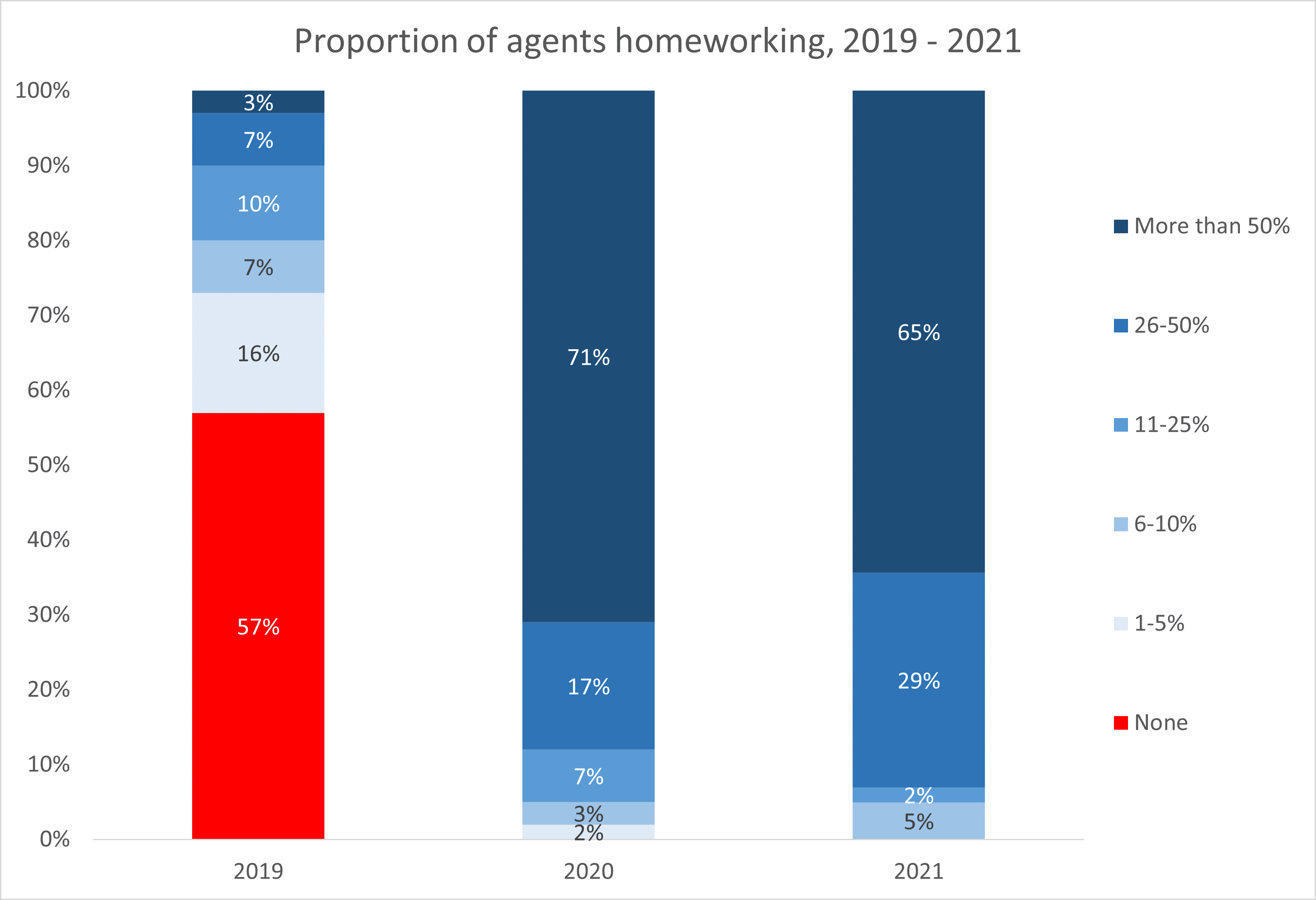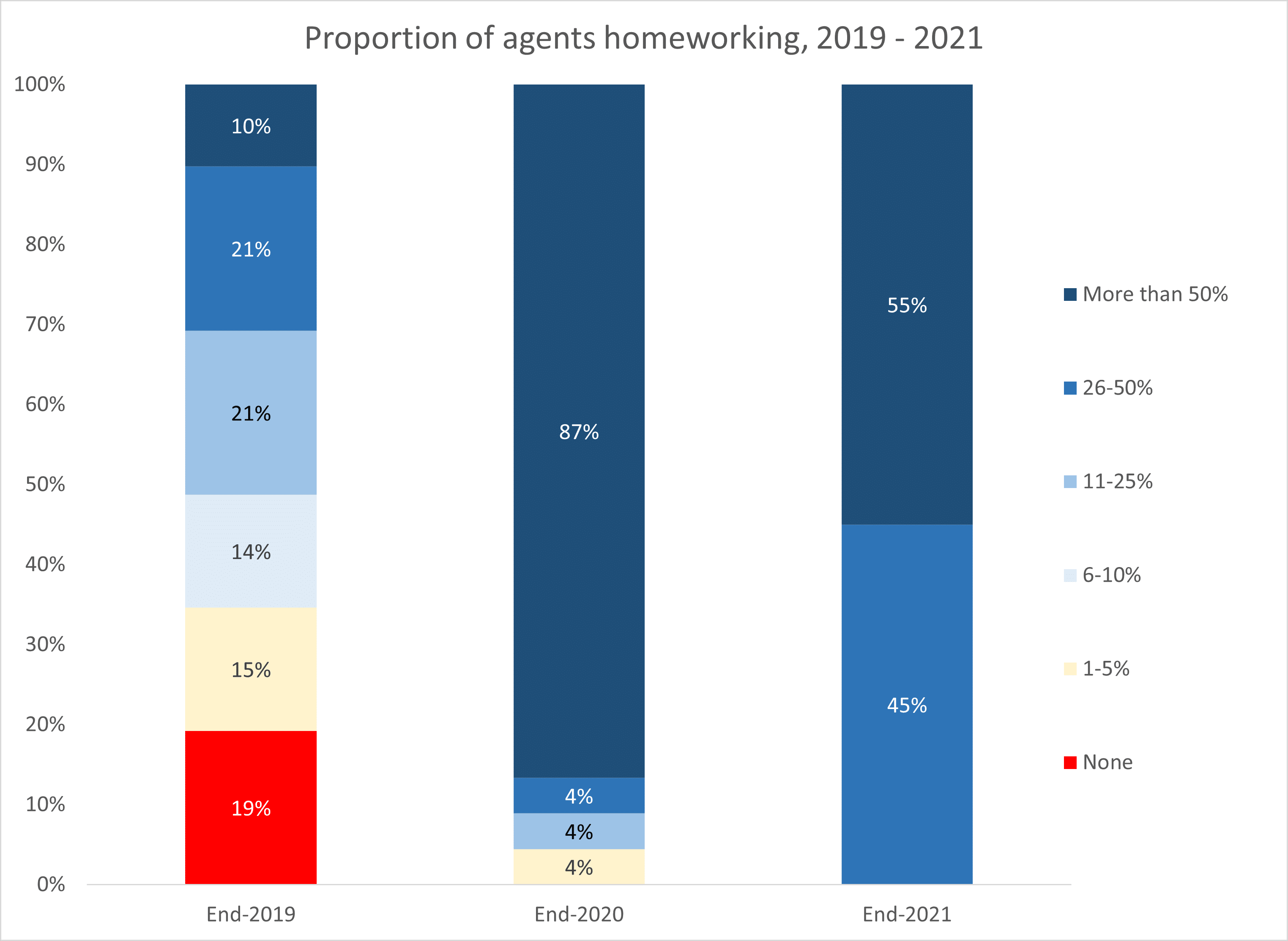Contact Centre Remote Working: Not Just for the Pandemic?
Recent ContactBabel surveys of over 400 contact centres in the UK and US show the extent to which remote working / homeworking has become the norm, and is expected to last beyond the pandemic.
Remote Working in the Contact Centre Industry
The COVID-19 pandemic has meant that homeworking / remote working has become vital to the business continuity plans of many contact centre operations. After the crisis has passed, businesses may well find that reverting to the previous centralised contact centre model is no longer optimal and that remote working can bring greater flexibility and performance, augmenting the traditional way of operating.
Remote working opens the door to the sorts of people who might not otherwise seek employment in a typical contact centre but who would happily work in their own home taking calls, and this opportunity to deepen and improve the quality of the labour pool without widespread pay increases should not be ignored.
Up until very recently, the majority of UK contact centres worked as a traditional, centralised model, with fewer than 4% of agents working remotely at home on a permanent basis. For the US, this figure was somewhat higher, but still only 13%.
Faced with the challenges of continuing to run contact centres in an environment decimated by coronavirus, many businesses urgently implemented business continuity plans which usually involved remote working.
The Current Use of Remote Working
Recent ContactBabel surveys of over 400 contact centres in the UK and US show the extent to which remote working / homeworking has become the norm.
The massive recent growth in remote working can be seen in the following chart: in 2019, 57% of UK contact centre survey respondents did not use any homeworking, a figure which was zero in 2020.
As shown in the chart below, 71% of UK operations had more than half of their agents working at home at the end of 2021, and there is expected to be only a very gradual decline in remote working, although much of this will be a hybrid home / office model.
Of course, this is likely to be a factor of the uncertainty surrounding the future and may well change significantly once confidence in public health is re-established.

In the US (below), this is even more pronounced, with 100% of operations surveyed having more than half of their agents working at home at least part of the time at the end of 2021.

Drivers & Inhibitors for Homeworking
The main homeworking benefits are usually reported to be around improved staffing flexibility and improved ability to handle overflow or unexpected volumes of traffic: in the same way that the virtualisation of multiple contact centre sites allows agents to be moved between virtual queues instantaneously, having a large pool of homeworkers to draw upon very quickly, as needed, can be a great advantage in handling call spikes.
This is certainly still the case, but of course the opportunity for business continuity that remote working provides is very clearly top of the agenda at the moment. The most important benefits of homeworking were said to be:
- Disaster recovery / business continuity
- Staffing flexibility
- Reduced equipment & building costs (UK) / Reducing staff attrition (US)
Homeworking is often credited with reducing agent attrition, as it takes away the stress, cost and time of the commute and enables the employee to work in less stressful, more personal surroundings. This allows the business to offer a more flexible working day to their employees, for example, a 4- or 5-hour shift in the middle of the day, allowing the employee to pick up and drop off their children at school, which may also coincide with the busiest period of the day for the organisation. In such cases, the employee is happy to work the hours that suit them, and the organisation bears less cost. Agents are far more likely to be able to work an hour or two in the evenings as well, allowing the contact centre opening hours to be longer.
When considering the inhibitors to homeworking, concerns over security and fraud were stated by 1 in 3 respondents to be the greatest hurdle, especially in the financial services sector, which is noticeably less enthusiastic in general about homeworking.
Working in an unsupervised environment is likely to mean that the potential risks for data theft and fraud are greater than in a closely supervised environment such as a traditional contact centre, especially if any physical paperwork is involved, payment card details taken or passwords written down. With the home workspace accessible to family members and visitors as well, risks are not just restricted to the homeworker.
The use of an automated payment card application – such as a third-party cloud-based solution – reduces the opportunity for deliberate card fraud, and definite policies around the storage and usage of equipment have to be agreed upon. There are various data access methods available that circumvent the need for written passwords, such as voice biometrics or coded key-fobs, and strong firewalls and encrypted hard drives will also reduce risk.
There is also some concern that it would be difficult to manage homeworkers effectively from a remote location, which has always been an objection to this way of working. Isolation can be a problem for both agent and management, and not all roles or agents are suitable for homeworking.
It is generally considered that new parents returning to work part-time, or older people who wish to reduce their working hours but who are not yet ready to retire completely are particularly suitable to be considered for homeworking roles, which require experience and maturity in the agent. With real-time adherence and call management systems in place, there is no real reason that a virtual contact centre made up of homeworkers is more difficult to manage than a ‘typical’ operation, although the role of the team-leader (being someone to help actively) has to be re-addressed.
For some contact centre workers, it would be difficult to have a room away from the noise of the household, and this is a concern for some businesses. Obviously, it’s important to consider working location on a case-by-case basis to assess the suitability of the agent for homeworking.
One of the previous greatest inhibitors to homeworking was that there was not seen to be a need to change the status quo: many respondents did not believe that homeworking would help with any business issue that they face. Clearly, the events of 2020 & 2021 have reversed this opinion.
Find out more:
To learn more about contact centre remote working / homeworking in the UK and US, please download:
The Inner Circle Guide to Contact Centre Remote Working Solutions (UK and US editions)

